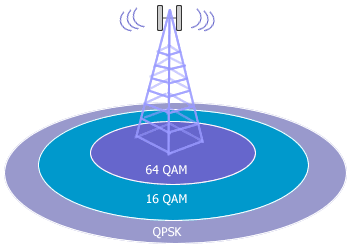Internet Access Guide : WiMAX
WiMAX performance (throughput and range) is determined by many
factors, i.e. on which frequency band it operates, channel
bandwidth, duplexing scheme (TDD or FDD), modulation (whether
BPSK, QPSK, 16-QAM, or 64-QAM) and code rate, antenna types, whether
LOS
or NLOS, transmit power, receiver sensitivity, and the number of
users per base station sector. It certainly varies from one case to another.
Looking from some pre-WiMAX implementations, fixed
broadband wireless access subscribers at average get 512 kbps - 2 Mbps
download data rate and 128 kbps - 1 Mbps upload rate in a NLOS environment
and PMP configuration. Fixed WiMAX
operators will likely multiply those rates up to several Mbps to
compete with DSL/cable. They can adjust the number of subscribers
that will be served by a Base Station sector based on the Service
Level Agreement (SLA) of each subscriber (or user) and the
maximum capacity per sector. For
PTP backhaul in a LOS environment, WiMAX capacity per
base station sector can reach 70 Mbps in a 20 MHz channel with
range over 30 miles. As for Mobile WiMAX, if WiBro - which is
deployed this year in Korea - is taken as a baseline, the
effective download and
upload rate per user will be over 1 Mbps outpacing 3G and enhanced 3G
(a.k.a. 3.5G) technologies such as EV-DO and
HSDPA.

Picture: Adaptive Modulation and Coding (AMC)
Users with better SNR (closer to the BS) get higher order modulation,
those farther from the BS get lower order modulation,
ensuring the best performance for each user within the BS coverage.
WiMAX offers a number of techniques that can improve its performance, i.e. throughput,
capacity,
coverage or range, indoor penetration. Some of these techniques are adaptive modulation and
coding (AMC), uplink subchannelization (using OFDMA), hybrid automatic repeat
request (H-ARQ), Forward Error Correction (FEC), and smart antenna
technologies (via optional AAS and
MIMO features). They can
improve performance by improving spectral efficiency or signal strength
(SNR).
Several Fixed WiMAX products (base stations and CPEs) have
become WiMAX Forum Certified after passing compliance and interoperability
tests last year (2005). That was the first round of certification.
Another round will follow and from the second half of this year
(2006) will include certification for Mobile WiMAX profiles. But
despite certification process is still in early phase, in many developing countries WiMAX has gained traction
with pre-WiMAX products being installed or trialed for providing fixed, nomadic, portable, or
mobile broadband access. Meanwhile, WISPs or
independent service providers are expected to be the first WiMAX
adopters in developed countries, many of them already have Fixed WiMAX-like products
installed for backhauling traffic from their access
networks.
|